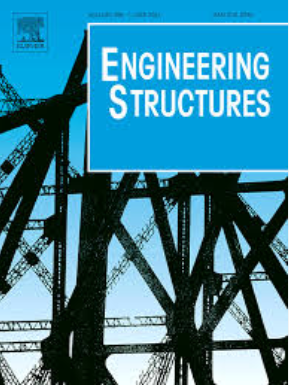二级结构单元对多层分段CLT剪力墙侧响应的影响
IF 6.4
1区 工程技术
Q1 ENGINEERING, CIVIL
引用次数: 0
摘要
交叉层压木材(CLT)剪力墙板的摇摆变形机制强调了对墙板与相邻/次级结构组件(地板、护墙和门楣)之间相互作用的更深入理解的必要性。然而,在实际设计中经常被忽视的地板和开口区域的细节对分段CLT剪力墙体系的横向响应的影响方面,研究仍然非常有限。因此,本研究旨在通过使用四种不同的数值模型来深入研究这些因素对多层多板分段CLT剪力墙侧向响应的影响。为此,对不同楼层数、墙板长宽比、楼板面外刚度和结构的各种原型进行单调推覆分析,以研究其横向响应的关键特征,如非线性变形能力、屈服层次和破坏模式。研究表明,二级结构单元和墙板宽高比对多层分段CLT剪力墙的侧向响应有显著影响。研究还表明,在女儿墙和门楣上使用几乎可以忽略不计的平面内侧移刚度的木结构单元,而不是CLT,可以改善分段CLT剪力墙的侧移性能。这样的墙能够保持一个与层内连接墙的相对横向刚度大致成正比的力分布,这导致连接墙上的延性连接几乎同时屈服,并防止了非延性连接的屈服或破坏。本文章由计算机程序翻译,如有差异,请以英文原文为准。
The effect of secondary structural elements on the lateral response of multi-story segmented CLT shear walls
The rocking deformation mechanism in Cross Laminated Timber (CLT) shear wall panels highlights the need for a deeper understanding of interactions between wall panels and adjacent/secondary structural components (floors, parapets and lintels). However, there remains a very limited body of research focused on the effects of floor panels and also the detailing of opening areas, which often neglected in practical design, on the lateral response of segmented CLT shear wall systems. This study, therefore, aims to thoroughly investigate the effect of these factors on the lateral response of multi-story multi-panel segmented CLT shear walls by using four different numerical models that differ in the inclusion of secondary elements. For this purpose, various archetypes differing in number of stories, wall panel aspect ratios, and floor panel out-of-plane stiffnesses and configurations are subjected to monotonic pushover analysis to investigate the key characteristics of their lateral response, such as nonlinear deformation capacity, yielding hierarchy, and failure modes. The study highlighted that secondary structural elements and wall panel aspect ratios significantly affect the lateral response of multi-story segmented CLT shear walls. The study also revealed that using wood-frame elements with almost negligible in-plane lateral stiffness for parapets and lintels, instead of CLT, can improve the lateral performance of segmented CLT shear walls. Such walls were able to maintain a force distribution approximately proportional to the relative lateral stiffness of the coupled walls within a story, which led to the almost simultaneous yielding of ductile connections across the coupled walls and prevented the yielding or failure of non-ductile connections.
求助全文
通过发布文献求助,成功后即可免费获取论文全文。
去求助
来源期刊

Engineering Structures
工程技术-工程:土木
CiteScore
10.20
自引率
14.50%
发文量
1385
审稿时长
67 days
期刊介绍:
Engineering Structures provides a forum for a broad blend of scientific and technical papers to reflect the evolving needs of the structural engineering and structural mechanics communities. Particularly welcome are contributions dealing with applications of structural engineering and mechanics principles in all areas of technology. The journal aspires to a broad and integrated coverage of the effects of dynamic loadings and of the modelling techniques whereby the structural response to these loadings may be computed.
The scope of Engineering Structures encompasses, but is not restricted to, the following areas: infrastructure engineering; earthquake engineering; structure-fluid-soil interaction; wind engineering; fire engineering; blast engineering; structural reliability/stability; life assessment/integrity; structural health monitoring; multi-hazard engineering; structural dynamics; optimization; expert systems; experimental modelling; performance-based design; multiscale analysis; value engineering.
Topics of interest include: tall buildings; innovative structures; environmentally responsive structures; bridges; stadiums; commercial and public buildings; transmission towers; television and telecommunication masts; foldable structures; cooling towers; plates and shells; suspension structures; protective structures; smart structures; nuclear reactors; dams; pressure vessels; pipelines; tunnels.
Engineering Structures also publishes review articles, short communications and discussions, book reviews, and a diary on international events related to any aspect of structural engineering.
 求助内容:
求助内容: 应助结果提醒方式:
应助结果提醒方式:


